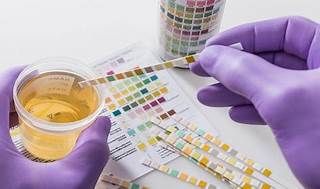The nurse is evaluating the fluid balance of a client who was admitted yesterday with dehydration and who has been receiving IV fluids since admission. An increase in which parameter indicates to the nurse that the client is rehydrating?
Urine specific gravity
Serum hematocrit
Pulse rate
Urinary output
The Correct Answer is D
Choice A reason: Urine specific gravity is a measure of the concentration of solutes in the urine. It is inversely related to the hydration status of the client. A high urine specific gravity indicates dehydration, while a low urine specific gravity indicates overhydration.
Choice B reason: Serum hematocrit is a measure of the percentage of red blood cells in the blood. It is also inversely related to the hydration status of the client. A high serum hematocrit indicates dehydration, while a low serum hematocrit indicates overhydration.
Choice C reason: Pulse rate is a measure of the frequency of the heartbeats. It is directly related to the hydration status of the client. A low pulse rate indicates dehydration, while a high pulse rate indicates overhydration.
Choice D reason: Urinary output is a measure of the amount of urine produced by the kidneys. It is directly related to the hydration status of the client. A low urinary output indicates dehydration, while a high urinary output indicates overhydration.
Nursing Test Bank
Naxlex Comprehensive Predictor Exams
Related Questions
Correct Answer is A
Explanation
The correct answer is A. Start collecting the specimen with the next void.
Choice A reason: The 4-hour urine collection for creatinine clearance should start with an empty bladder. The first urine of the day is discarded and the time is noted. All subsequent urine for the next 4 hours, including the first urine the following day, should be collected. If the first sample was put in the urinal hours ago and was not collected, the nurse should start collecting the specimen with the next void.
Choice B reason: Beginning the collection the next day would delay the test and may not be necessary. The test should ideally start after the first urine of the day is discarded.
Choice C reason: Observing the sample for sediment is not typically part of the procedure for a 4-hour urine collection for creatinine clearance. The focus is on collecting all urine for a specified period, not on the physical characteristics of the sample.
Choice D reason: Emptying the sample into the 4-hour container would be incorrect if the sample was the first urine of the day, which should be discarded. The collection should start with the next void.

Correct Answer is D
Explanation
Choice A reason: This is not the best intervention as it does not address the cause of the pain or provide adequate relief. Deep breathing may help the client to relax and cope with the pain, but it is not enough to manage severe pain.
Choice B reason: This is not a true or helpful statement as it may imply that the nurse is dismissing the client's pain or delaying further action. Oxycodone is a fast-acting opioid analgesic that reaches its peak effect within 30 to 60 minutes. If the client is still in severe pain after one hour, the nurse should reassess the pain and notify the healthcare provider.
Choice C reason: This is not the priority intervention as it does not address the cause of the pain or provide adequate relief. A backrub may help the client to relax and distract from the pain, but it is not enough to manage severe pain.
Choice D reason: This is the best intervention as it helps the nurse to evaluate the effectiveness of the medication and the need for further intervention. The nurse should use a valid and reliable pain assessment tool and ask the client about the location, intensity, quality, and duration of the pain. The nurse should also check the client's vital signs and observe for any signs of adverse effects from the medication.
Whether you are a student looking to ace your exams or a practicing nurse seeking to enhance your expertise , our nursing education contents will empower you with the confidence and competence to make a difference in the lives of patients and become a respected leader in the healthcare field.
Visit Naxlex, invest in your future and unlock endless possibilities with our unparalleled nursing education contents today
Report Wrong Answer on the Current Question
Do you disagree with the answer? If yes, what is your expected answer? Explain.
Kindly be descriptive with the issue you are facing.
